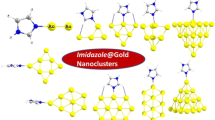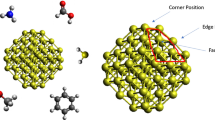Abstract
In this study, we highlight the benefits and limits of using density-functional tight-binding (DFTB) with respect to standard density functional theory (DFT). The DFTB method is found to reliably reproduce the DFT adsorption energies and geometries. Overall, our results suggest that DFTB is a good reference method to set the correct chemical states and the initial geometries of proline interacting with gold cluster. The frontier orbitals energies suggest that in proline–gold cluster complex, the proline molecule can only act as an electron donor and the gold cluster as acceptor. The analysis of the electronic properties for arginine, arginine dipeptide, and TAT peptide which underline the role on the interaction of the s-like H states with the d-like Au states produces both bonding and anti-bonding occupied orbitals, and the process is well described by a model for the interaction of localized orbitals with narrow-band dispersive electron states. The bonding orbitals well below the metal Fermi level contribute to the adsorption of arginine, arginine dipeptide, and TAT peptide on gold.










Similar content being viewed by others
References
Love JC, Estroffi LA, Kriebel JK, Nuzzo RG, Whitesides GM (2005) Chem Rev 105:1103
Hakkinem H (2012) Nat Chem 4:443
Murton SM, Silverstein DW, Jensen L (2011) Chem Rev 111:3962
Harnta M (1997) Catal Today 36:153
Gorin D, Sherry B, Toste FD (2008) Chem Rev 108:3351
Hainfeld JF, Slatkin DN, Focella TM, Smilowitz HM (2006) Br J Radiol 79(939):248–253
Kennedy LC, Bickford LR, Lewinski NA, Coughling AJ, Hu Y, Day ES, West JL, Drezek RA (2011) Small 7:169
Retnakumari A, Setua S, Menon D, Ravindran P, Muhammed H, Pradeep T, Nair S, Koyakutty M (2010) Nanotechnology 21:055103
Qian X, Peng X, Ansari DO, Yin-Goen Q, Chen GZ, Yang L, Young AN, Wang MD, Nie S (2008) Nat Biotechnol 26:83
Arvizo R, Bhattacharya R, Mukherjee P (2010) Expert Opin Drug Deliv 7(6):753–763
Boisselier E, Astruc D (2009) Chem Soc Rev 38:1759–1782
Eltsner M (2006) Theor Chem Acc 116:316–325
Duarte H, Heine T, Seifert G (2005) Theor Chem Acc 114:68–75
van Mourik T, Hogan SWL (2016) Struct Chem 27:145
Fihey A, Hettich C, Touzeon J, Maucel FC, Perrier A, Kohler C, Aradi B, Frauenheim T (2015) J Comput Chem 36:2075–2087
Elstner M (2007) J Phys Chem A 111:5614
Elstner M, Porezag D, Jungnickel G, Elsner J, Haugk M, Frauenheim T, Suhai S, Seifert G (1998) Phys Rev B 58:7260
Porezag D, Frauenheim T, Kohler T, Seifert G, Kaschner R (1995) Phys Rev B 51:12947
Elstner M, Frauenheim T, Suhai S (2003) J Mol Struct Theochem 632:29
Seifert G (2007) J Phys Chem A 111:5609
Oliveira AF, Seifert G, Heine T, Duarte HA (2009) J Braz Chem Soc 20(7):1193–1205
Slater JC, Kostner GF (1954) Phys Rev 94:1498
Koskinen P, Makinen V (2009) Comput Mater Sci 47:237–253
Humphrey W, Dalke A, Schulten K, VMD-Visual Molecular Dynamics (1996) J Molec Graphics 14(1):33–38
Aradi B, Hourahine B, Frauenheim T (2007) J Phys Chem A 111:5678
Zhechkov L, Heine Th, Patchkovskii S, Seifert G, Duarte HA (2005) J Chem Theory Comput 32(1):841–847
Rappe AK, Casewit CJ, Colwell KS, Goddard WA III, Skiff WM (1992) J Am Chem Soc 32(114):10024–10035
Kruger D, Fuchs H, Rousseau D, Marx D, Parrinello M (2002) Phys Rev 89:186402
Rai S, Kumar NVS, Singh H (2012) Bull Mater Sci 35(3):291–295
Pakiari AH, Jamshidi Z (2007) J Phys Chem A 111:4391
Janak JF (1978) Phys Rev B 18:7165–7168
Perdew JP, Zunger A (1981) Phys Rev B 23:5048–5079
Dennison SR et al (2007) Biochem Biophy Res Commun 363:178
Futaki S (2005) Adv Drug Deliv Rev 57:547
Saha S, Roy RK, Ayers PW (2009) Int J Quant Chem 109:1790–1806
Hammer B, Nørskov JK (1997) In Theory of Adorption and Surface Reactions. In: Lambert RM, Pacchioni G (eds) Chemisorption and reactivity of supported clusters and thin films. Kluwer Academic Publishers, Dordrecht
Li W, Kotsis K, Manzhos S (2016) Phys Chem Chem Phys 18:19902–19917
Di Felice R, Selloni A, Molinari E (2003) J Phys Chem B 107:1151–1156
Martyna GJ, Klein ML, Tuckerman M (1992) J Chem Phys 97:2635–2643
Frenkel S (2002) Molecular simulation—from algorithms to applications (W.C. Wang, Trans.). Chemical Industry Press, Beijing
Shi WY, Ding C, Yan JL, Han XY, Lv ZM, Lei W, Xia MZ, Wang FY (2012) Desalination 291:8–14
Ying-xue J, Feng-he W, Lun-chao D, Fan Z, Xue-dong G (2013) Appl Surf Sci 285:403–408
Domínguez-Castro F, Guzman Y (2017) Novo-Fernandez. Comput Theor Chem 1102:30–37
Xue Y, Datta S, Ratner MA (2001) J Chem Phys 115:4292
Acknowledgements
This work was supported by the Ministry of Higher Education (MES) of the Republic of Cuba as part of a scientific project of Higher Institute for Technologies and Applied Sciences (InSTEC). We would also like to thank Advanced Computational Team at Higher Institute of Technologies and Applied Sciences for the support provided during the realization of this work.
Author information
Authors and Affiliations
Contributions
The manuscript was written through contributions of all authors. All authors have given approval to the final version of the manuscript.
Corresponding authors
Ethics declarations
Conflict of interest
The authors declare no competing financial interest.
Rights and permissions
About this article
Cite this article
Domínguez-Castro, A., Hernández, D. & Guzmán, F. Insights into the interactions of biomolecules with small gold clusters: a theoretical study from a DFTB perspective. Theor Chem Acc 136, 84 (2017). https://doi.org/10.1007/s00214-017-2118-7
Received:
Accepted:
Published:
DOI: https://doi.org/10.1007/s00214-017-2118-7




